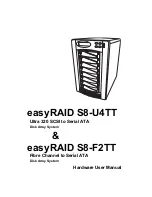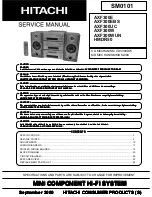
FASTORA DAS-315SA Disk Array
113
be data lost or made unavailable.
The RAID redundancy schemes are capable of regenerating the data from a
failed disk drive. After a disk has failed, it can be replaced by a spare (called a
“hot spare” if it is always resident and powered up in the subsystem) and the
data can then be rebuilt on the replacement disk. The overhead associated
with the rebuilding process may affect storage “throughput”, which is the data
access rate that can be serviced by the storage subsystem. Depending on the
application of the data processing system, storage throughput is measured by
transaction
rate
or
transfer rate
(or both). Transaction rate is expressed in
input/output, or I/O, operations per second (
IOPS
or
IO/s
). Transfer rate is
expressed in millions of bytes transferred per second (
MBPS
or
MB/s
).
Two other shortcomings of RAID are shared with disk drives in general:
seek
and
latency
. Seek is the time it takes to move the read/write (R/W) heads to
the location of the data, and latency is the time it takes for the specific data to
spin around under the R/W head. Average latency for a disk is ½ a revolution.
RAID can make latency worse if, as in RAID levels 2 and 3, multiple disks store
the data and the disks are not rotationally synchronized. A disk feature called
“spindle synchronization” can overcome this drawback, but not all disks offer
the feature.
A.2 RAID 0
This is not a true RAID as defined by the Berkeley group, but rather a
colloquial addition to describe the typical “disk farm” used by midrange and
larger computers. A technique called “striping” or “spanning” increases the
effective data transfer rate by dividing up the data file into smaller blocks and
recording them on separate disks. Susceptibility to failure is increased
because any particular disk stores a portion of many data files; if a disk is lost,















































